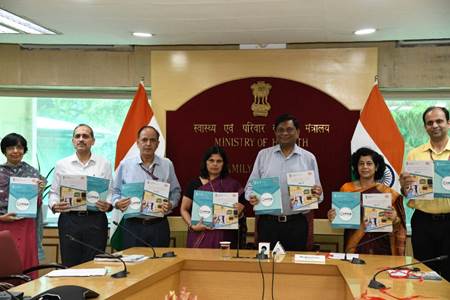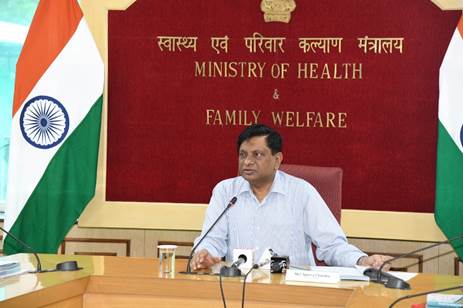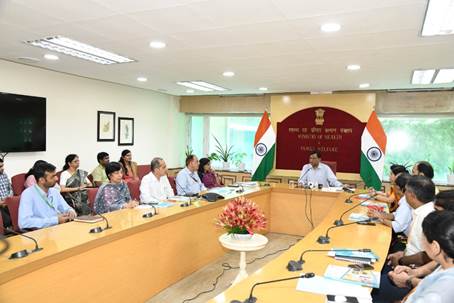Ministry of Health and Family Welfare
Health Ministry Releases "Health Dynamics of India (Infrastructure and Human Resources) 2022-23"
The annual publication is a valuable document furnishing much needed information on manpower and infrastructure within NHM, helpful in policy making, improving processes and problem solving: Union Health Secretary
“Need to integrate the HMIS Portal with RCH and other portals of the Ministry to reduce the burden of work of health functionaries and to ensure that the data are uploaded timely and analyzed carefully”
प्रविष्टि तिथि:
09 SEP 2024 12:38PM by PIB Delhi
Union Health Secretary, Shri Apurva Chandra released "Health Dynamics of India (Infrastructure and Human Resources) 2022-23", an annual publication formerly known as “Rural Health Statistics”, here today. The document has been published since 1992.

Highlighting the document as a source of reliable and authentic information on various aspects of National Health Mission (NHM), Shri Apurva Chandra stated that “The annual publication is a valuable document furnishing much needed information on manpower and infrastructure within NHM, helpful in policy making, improving processes and problem solving”. He added that the document gives a cross analysis across the states on the availability and deficiencies in manpower and infrastructure. The data is immensely helpful in understanding the requirements of the states, their priority areas and formulating policies and targeted campaigns, he said. The health statistics also aids in making a comparison in the performance of the states on different parameters, he highlighted.

Union Health Secretary also pointed at the “need to integrate the Health Management Information System (HMIS) Portal with Reproductive and Child Health (RCH) and other portals of the Ministry to reduce the burden of work of health functionaries and to ensure that the data are uploaded timely and analysed carefully.”

Background:
Since 1992, the publication has provided detailed annual data on health infrastructure and human resources, with updates as of March 31 each year. This data is crucial for stakeholders in the health sector, as it supports effective planning, monitoring, and management of health infrastructure across the country. By providing a clear snapshot of the current state of healthcare infrastructure and human resources, the publication serves as a foundational tool for identifying gaps and addressing needs in various areas, including rural, urban, and tribal regions.
It is structured in two parts:
Part 1 presents an overall view of India's healthcare system with State and Union Territory profiles, using visual aids like maps and charts for clarity.
Part 2 is divided into nine sections, offering in-depth data on health facilities, manpower, and demographic indicators.
The information contained in the publication enables policymakers, health administrators, and planners to assess the distribution and adequacy of healthcare facilities and human resources. It helps in formulating targeted strategies to optimize health service delivery and allocate resources efficiently. Additionally, the data serves as a vision document for understanding the needs in different regions, facilitating a more equitable distribution of health services.
Overall, the publication is an essential resource material for ensuring that health infrastructure development is aligned with the specific requirements of all population groups, ultimately contributing to a more resilient and responsive healthcare system across the country.
As of March 31, 2023, the country has a total of 1,69,615 Sub-Centres (SCs), 31,882 Primary Health Centres (PHCs), 6,359 Community Health Centres (CHCs), 1,340 Sub-Divisional/District Hospitals (SDHs), 714 District Hospitals (DHs), and 362 Medical Colleges (MCs) serving both rural and urban areas.
These healthcare infrastructures are supported by 2,39,911 Health Worker (Male + Female) at SCs, 40,583 Doctors/Medical Officers at PHCs, 26,280 Specialists & Medical Officers at CHCs, and 45,027 Doctors and Specialists at SDHs and DHs. Additionally, there are 47,932 Staff Nurses at PHCs, 51,059 Nursing Staff at CHCs, and 1,35,793 Paramedical Staff at SDHs and DHs across the country.
The publication “Health Dynamics of India (Infrastructure and Human Resources) 2022-23” can be accessed under Documents Section on the Ministry of Health & Family Welfare website by using the link: https://mohfw.gov.in/.
The key features of the publication include:
- Comparative Analysis: Provides comparisons of health infrastructure and manpower between 2005 and 2023, and from 2022 to 2023, highlighting progress and gaps.
- District-Wise Data: Offers district-level details of health facilities, including Sub-Centers (SCs), Primary Health Centers (PHCs), Community Health Centers (CHCs), Sub-District Hospitals (SDHs), District Hospitals (DHs), and Medical Colleges.
- Rural, Urban, and Tribal Focus: Details infrastructure and manpower in rural, urban, and tribal areas, providing targeted insights for policy planning.
- Classification of States/UTs: States and Union Territories are categorized based on key healthcare performance metrics, aiding in targeted interventions.
- User-Friendly Highlights: Key findings are summarized at the beginning for quick reference.
- Guidance for Stakeholders: Acts as a crucial tool for healthcare planning and management by identifying gaps and deficiencies in infrastructure and human resources.
Smt. Aradhana Patnaik, Addl. Secretary and Mission Director (NHM), Health Ministry and senior officials of the Union Health Ministry were present at the event.
*****
MV
HFW/HDI Publication Release/09September2024/1
(रिलीज़ आईडी: 2053070)
आगंतुक पटल : 8787